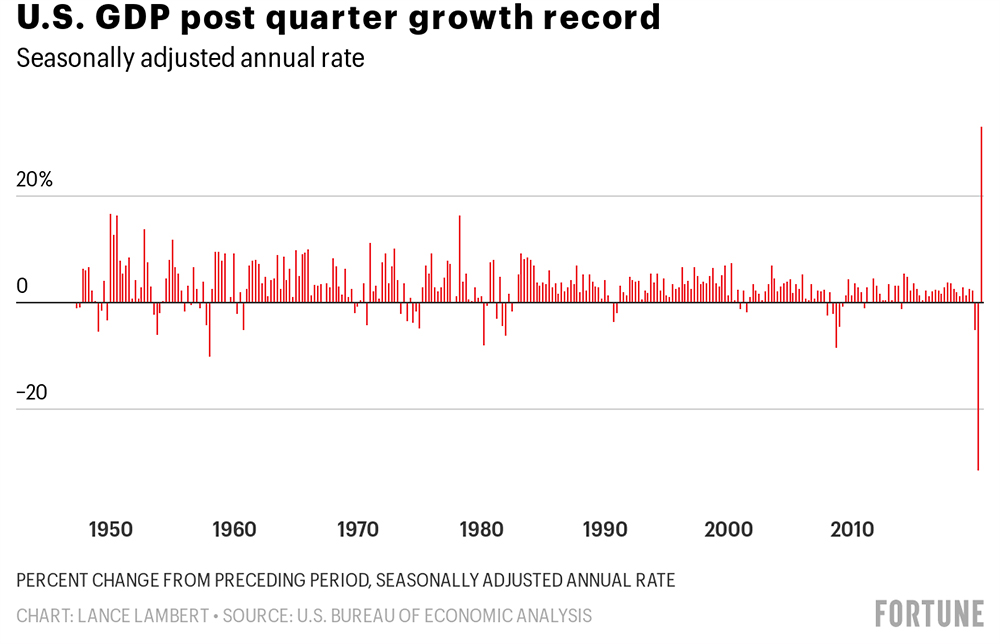美国GDP实现史上最强劲回升,已经走出困境了?
美国近三个月的经济回升速度堪称史上最快。
据美国经济分析局(U.S. Bureau of Economic Analysis)于10月29日公布的数据,今年第三季度,即7月至9月期间,美国国内生产总值(GDP)较去年同期增长了33.1%。
早前的一、二季度,美国GDP曾经遭受创记录式的下跌,其年化降幅分别达到了5%及31.4%。这种跌幅一度让众多经济学家陷入恐慌,整个美国乃至全球似乎都站在了“经济大萧条”的悬崖边上。出人意料的是,自各州在夏季逐渐开放封锁限制以来,美国经济正在摆脱深度萎缩的泥沼,实现迅猛增长。
第三季度GDP是美国总统大选前最后一个最重要的经济参考指标。数据一经发布,特朗普便开始庆祝起来。
GDP数据刚刚发布了。这是我国有史以来最好的成绩,没有先例。明年会更好的!!!但是昏昏欲睡的拜登和他的增税计划显然会毁了这一切。还好GDP数据在11月3号前公布,我太开心了!
— 唐纳德•特朗普 (@realDonaldTrump) 2020年10月29日
但美国仍未走出困境。今年前两个季度,美国折合成年率的GDP总值由21.8万亿美元降至了19.5万亿美元。这一季度,该数值虽然回升到了21.2万亿美元左右,却仍然低于年前。

事实上,美国已经进入经济复苏瓶颈期。夏季解除封锁之初,类似于牙医诊所、理发店这样人流量较为有限的场所得以快速回归,自5月起,美国共有1140万个工作岗位恢复常态。然而到了疫情后期,酒店、会所等人流量密集场所迟迟不得复业,社会岗位增速由此放缓。目前美国仍然较疫情前缩减了1070万个工作岗位,其中380万个岗位正是集中在酒店及休闲娱乐业。
“第四季度的数据未必会有那么好看,到时候经济复苏的脆弱面貌就会浮现出来。现时数据只是体现出了政府大规模财政刺激下的滞后效应,如果新冠确诊病例继续激增,那么这种效应就会衰退。”穆迪投资者服务公司(Moody’s Investors Service)的副总裁马德哈维•伯克利在GDP数据发布后写道。
此外,虽然美国GDP出现了“V字型”回升,但就业率却不容乐观。美国9月只增了66.1万个岗位,如果按照这个速度,可能要到2022年,也就是花费16个月才能够恢复到疫情前水平。同时企业招聘步伐也将放缓,这意味着可能要到2023年甚至更远以后,才可以实现全面就业。
有常言道,股市走向不代表经济走向。借而用之则可见,GDP走向亦不代表人民生活走向。(财富中文网)
编译:陈怡轩
美国近三个月的经济回升速度堪称史上最快。
据美国经济分析局(U.S. Bureau of Economic Analysis)于10月29日公布的数据,今年第三季度,即7月至9月期间,美国国内生产总值(GDP)较去年同期增长了33.1%。
早前的一、二季度,美国GDP曾经遭受创记录式的下跌,其年化降幅分别达到了5%及31.4%。这种跌幅一度让众多经济学家陷入恐慌,整个美国乃至全球似乎都站在了“经济大萧条”的悬崖边上。出人意料的是,自各州在夏季逐渐开放封锁限制以来,美国经济正在摆脱深度萎缩的泥沼,实现迅猛增长。
第三季度GDP是美国总统大选前最后一个最重要的经济参考指标。数据一经发布,特朗普便开始庆祝起来。
GDP数据刚刚发布了。这是我国有史以来最好的成绩,没有先例。明年会更好的!!!但是昏昏欲睡的拜登和他的增税计划显然会毁了这一切。还好GDP数据在11月3号前公布,我太开心了!
— 唐纳德•特朗普 (@realDonaldTrump) 2020年10月29日
但美国仍未走出困境。今年前两个季度,美国折合成年率的GDP总值由21.8万亿美元降至了19.5万亿美元。这一季度,该数值虽然回升到了21.2万亿美元左右,却仍然低于年前。
事实上,美国已经进入经济复苏瓶颈期。夏季解除封锁之初,类似于牙医诊所、理发店这样人流量较为有限的场所得以快速回归,自5月起,美国共有1140万个工作岗位恢复常态。然而到了疫情后期,酒店、会所等人流量密集场所迟迟不得复业,社会岗位增速由此放缓。目前美国仍然较疫情前缩减了1070万个工作岗位,其中380万个岗位正是集中在酒店及休闲娱乐业。
“第四季度的数据未必会有那么好看,到时候经济复苏的脆弱面貌就会浮现出来。现时数据只是体现出了政府大规模财政刺激下的滞后效应,如果新冠确诊病例继续激增,那么这种效应就会衰退。”穆迪投资者服务公司(Moody’s Investors Service)的副总裁马德哈维•伯克利在GDP数据发布后写道。
此外,虽然美国GDP出现了“V字型”回升,但就业率却不容乐观。美国9月只增了66.1万个岗位,如果按照这个速度,可能要到2022年,也就是花费16个月才能够恢复到疫情前水平。同时企业招聘步伐也将放缓,这意味着可能要到2023年甚至更远以后,才可以实现全面就业。
有常言道,股市走向不代表经济走向。借而用之则可见,GDP走向亦不代表人民生活走向。(财富中文网)
编译:陈怡轩
The economy just experienced its fastest three months of growth in U.S. history.
In the third quarter, from July to September, GDP climbed 33.1% on an annualized basis, according to data released on October 29 by the U.S. Bureau of Economic Analysis.
This historic climb follows the U.S. record 31.4% annualized GDP decline in the second quarter and the 5% annualized decline in the first quarter. During that period economists around the world were in a panic and questioning if the United States—as well as the rest of the world—was on the cusp of an economic depression. But once states began to ease lockdown restrictions in the summer, the U.S. economy sprung from deep contraction to high growth.
It's the last major piece of economic data before Election Day, and President Trump was quick to celebrate the numbers.
GDP number just announced. Biggest and Best in the History of our Country, and not even close. Next year will be FANTASTIC!!! However, Sleepy Joe Biden and his proposed record setting tax increase, would kill it all. So glad this great GDP number came out before November 3rd.
— Donald J. Trump (@realDonaldTrump) October 29, 2020
But we're still in the hole. Over the course of the first two quarters, annualized U.S. GDP fell from $21.8 trillion to $19.5 trillion. In the third quarter that swung back up to about $21.2 trillion.
And the easy economic gains are over. When states reopened this summer, jobs at places of business without mass crowds, like dental offices and barber shops, came back quickly. In all, 11.4 million jobs have returned since May. But with the pandemic still raging across the nation, businesses like hotels and event venues are far from pre-pandemic employment levels. Indeed, the economy is still down 10.7 million jobs, including 3.8 million in leisure and hospitality.
"The fourth-quarter numbers may tell a less robust story, exposing the tenuous nature of this recovery. The lagged effects of fiscal support provided through the CARES Act are fading at a time when COVID cases are surging," wrote Madhavi Bokil, vice president of Moody’s Investors Service, following the GDP release.
But while GDP is seeing something closer to a V-shaped recovery—bouncing back nearly as fast as it fell—that isn't the case for U.S. employment. The U.S. added 661,000 jobs in September. If that pace were to continue, it would take over 16 months—into 2022—to recover all the jobs lost during the COVID-19 recession. The issue? That pace of hiring is expected to slow further, meaning a full employment recovery could take until 2023 or longer.
It's often said that the stock market isn't the economy. But it's also true that the economy—or at least the GDP—isn't us.













